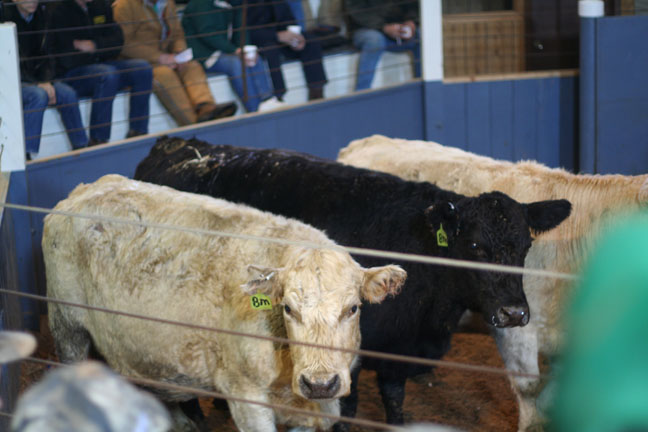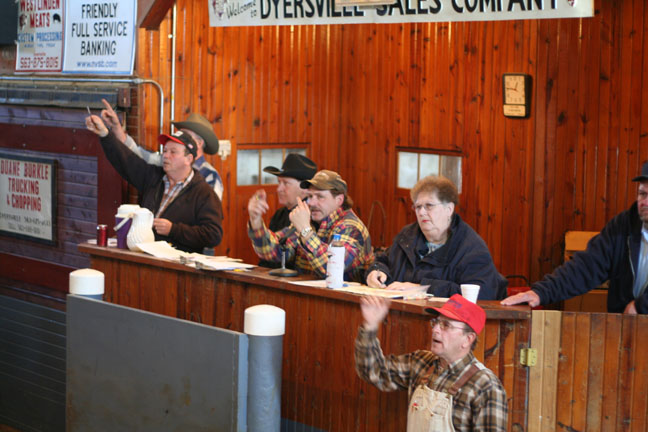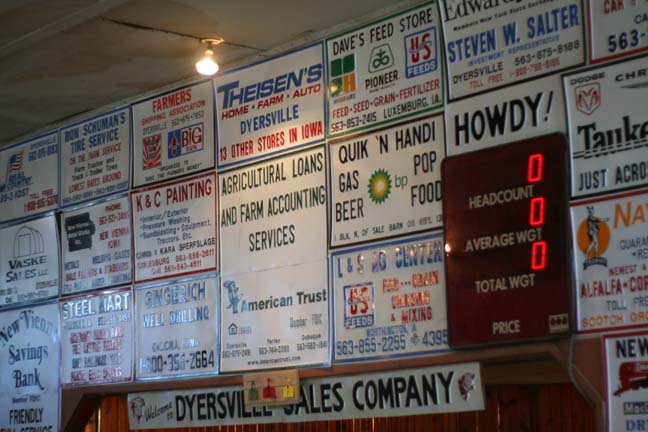
A couple of posts ago I mentioned that we were debating about expanding our beef business or not. Well, we decided to go the route of expansion. One good thing about being in the food business is that if you fail, at least you can eat your products. So last Saturday we were off to the sale barn.
We’ve built our cow herd at the sale barn, buying at special bred cow sales. Many (if not most) cattle producers will tell you you’ve got to invest in good genetics and advise against buying at the sale barn. But for us it’s been an inexpensive way to get going, and also to buy just 2 or 3 cows at a time.
Overall we’ve had excellent results with our cows. But you have to know what to look for and what to look out for. It’s definitely a “buyer beware” proposition with no guarantees. We’ve been burned a couple of times. One bred cow we bought turned out to have Johnes disease and we lost both her and her calf. A bottle calf we bought had something wrong with its digestive tract. You could feed him, but nothing would come out the other end and he died soon after bringing him home.
But buying purebreds is not necessarily going to be without troubles, either. As my brother likes to remind me, “If you’ve got livestock, you’re going to have deadstock.” He’s wise, that one.
Our favorite sale barn is in Dyersville. There are sale barns closer to us, but we think Dyersville is worth the trip because they usually have a good selection of what we’re looking for. Better to drive 2 1/2 hours and come home with a full trailer than to drive an hour but pull back an empty trailer. Anyway, the sale barn is our idea of a fun date 🙂

If you’re new to livestock sale barns, visit the ones around you a couple of times before you buy anything. You’ll get a feel for what they usually offer and how they run things. You’ll notice who the regulars are – the auctioneers will call on them by name. Strike up a conversation with one of them and ask some questions.
When buying bred cows there’s 2 pieces of information the auctioneer will give you – the cow’s age and what trimester she’s in (cow’s have a 9-month gestation just like humans.) Age will be in years, or “SS” or “BM”. “SS” stands for “short solid mouth”, which means her teeth are wore down but still intact. She’s probably somewhere around 7 to 9 years old. “BM” stands for “broken mouth” which means she’s started to lose some teeth and is an older cow. We came home with a 6 year old, an 8 year old, and a “SS”.
The auctioneer should also say what trimester (or “period”) the cow is in – 1st, 2nd or 3rd. At Dyersville they also put color-coded eartags in to designate the period. But the auctioneer might also say such things as “she’ll calve on grass for you” meaning she’ll calve in May or June.
Beyond that you want to look for a cow that looks generally active and alert, but not too wild. A skinny cow isn’t necessarily a sign of bad health. Most likely she’s just been underfed. We bought some of the plumpest looking cows at the salebarn, but when we got them home next to our own cows they looked like skinny minnies! They’ve been at the hay feeder constantly since they got here and they’re starting to look better. Also a mangy looking cow isn’t necessarily a sign of bad health. Some pour-on when you get her home and she’ll probably be fine. But if you’re not using pour-on in your operation you’ll want to avoid those cows.
You’ll want to get to the auction with plenty of time before it starts to walk around the pens and yards and see what’s there to buy. Bring a pad of paper and a pen so you can write down the numbers on the ones you’re interested in, so you’ll recognize them once they’re in the ring. Things can sometimes move pretty fast.
Watch out – sale barns can be addicting 🙂 It’s probably a good thing Dyersville is so far away!

The advertising wall at Dyersville sale barn.


In Denmark we have only one or two sales back.The risk of bringing home viruses and other nice things makes most of the holders stay away from using the sales.But I remember the special feeling by being there.
Very good post! If I had to do it all again and was just starting out the sale barn would save 10s of thousands if a person knew what to do. Stay away from a group of fancy blacks, go for a mix or better yet some herefords that are going for half or under the “fancies”. Also, through the years here my best cows, and I mean the really good ones, would be the ones that would bring the least at a sale, not enough eye appeal. And another thing, the worst cows I ever had by a long shot were the “good genetics” kind bought from a big time breeder. All the numbers were right, but the cows were the worst bunch anyone could possibly get. Have a good time down there!
i imagine that the sale barn is like anywhere. the reasons for selling vary from, unsavory stock to a mode of business. my father-in-law raises grass fed mothers & their offspring. the calves only reach a weaned age before he sells them to someone else to fatten however they choose–grass fed or grain fed. his situation only warrrants this part of the process. it seems you keep your self well informed and have a good eye. best of luck building your herd.
Wow, that brought back memories as my grandparents were always at the auction right down the street from their farm.Fun post!What did you have for dinner last night? Corn “something?” LOL.
Thanks for the welcome! I can relate to your comments on the sale barn. My experience has been mostly at horse sales, altho the atmosphere, friendly people, and aroma are similar anywhere.
I just have to say – I absolutely love your blog! I stayed up until 3 AM one morning reading through all of your old posts. I’m in college, and I check your blog sometimes while I am in class and the people behind me always laugh, “Are you reading about chickens again?” Haha. I love it, though!My future husband and I plan to live on a somewhat self-sufficient farm one day similar to yours. We are going to try some meat chickens and a big garden this summer as a learning experience! Thank you for sharing all of your knowledge!
i know how you can slip a few corn packs in for lunches. macaroni and cheese. make per-box-instructions and add frozen corn into almost cooked noodles, bring to simmer again and drain. grate a little extra cheese into the sauce–asiago is our favorite.a meal fit for a king…
Your post was perfect timing as I’ve got our spring herd funds available and told hubby that I was going to start hitting one of the local barn sales soon to start learning. You’ve given some good tips here and I’ll remember them. We have a crazy cow who thinks she’s a pet and we need more cows to teach her how to be, well, more like a cow.